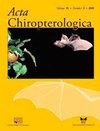南美洲干对角线地区三斑叶蕨的分布模型和生境要求
IF 0.7
4区 生物学
Q4 ZOOLOGY
引用次数: 2
摘要
桑伯尼微孢子虫是一种食虫蝙蝠,分布范围尚不清楚,但在南美洲干旱的植物地理区已知。在这里,我们根据与该物种发生相关的七个生物气候和植被预测因子,使用Caatinga(16)、Cerrado(7)、Chiquitano干林(2)和Pantanal(1)中记录该物种的26个地点,对该物种的分布进行了建模。我们使用了四种不同的算法来建立一个集合分布模型,以估计整个地理位置的栖息地适宜性以及保护区内可用的栖息地面积。我们的模型表现出了优异的性能,并强调了四个环境变量(其他混合树木、落叶阔叶树、常绿阔叶树和最干旱地区的降水)的主要重要性,这四个变量占物种存在概率的80%以上。分布模型表明,桑博尼M.sanborni在南美洲干燥的对角线上持续存在,但适当的栖息地主要覆盖卡廷加和塞拉多东北部,而不是西南部,那里的适当栖息地分散且不连续。桑博尼M.sanborni预计的总栖息地中,只有不到10%属于保护区。我们的研究结果支持桑博尼主要依赖南美洲干旱对角线上的木本和不太干燥的环境,这引发了人们对其脆弱性的担忧,因为西南部的森林砍伐率很高,而且巴西东北部预计未来几十年将出现严重干旱。本文章由计算机程序翻译,如有差异,请以英文原文为准。
Distribution Modelling and Habitat Requirements of Micronycteris sanborni (Phyllostomidae) across the South America Dry Diagonal
Micronycteris sanborni is an insectivorous bat known from dry phytogeographic domains in South America, although its distribution range is not yet well known. Here, we modelled the distribution of this species based on seven bioclimatic and vegetation predictors associated with its occurrence, using 26 sites where the species was recorded in the Caatinga (16), Cerrado (7), Chiquitano Dry Forest (2) and Pantanal (1). We used four different algorithms to build an ensemble distribution model, to estimate habitat suitability throughout its geographic occurrence and the area of habitat available inside protected areas. Our models showed excellent performance and highlighted the main importance of four environmental variables (other mixed trees, deciduous broadleaf trees, evergreen broadleaf trees, and precipitation of driest quarter), which accounted for more than 80% of the species presence probability. The distribution model indicated the potential occurrence of M. sanborni consistently across the dry diagonal of South America, but adequate habitat areas covered mainly the Caatinga and the northeast of Cerrado rather than the southwest, where suitable habitats were scattered and discontinuous. Less than 10% of the total habitat predicted for M. sanborni corresponded to protected areas. Our results support that M. sanborni mostly depends on woody and less dry environments across the South America dry diagonal, which raises concerns about its vulnerability due to high deforestation in the southwest and because severe dryness is forecast for the coming decades in the Brazilian northeast.
求助全文
通过发布文献求助,成功后即可免费获取论文全文。
去求助
来源期刊

Acta Chiropterologica
生物-动物学
CiteScore
2.50
自引率
20.00%
发文量
42
审稿时长
>12 weeks
期刊介绍:
Acta Chiropterologica, published by the Museum and Institute of Zoology at the Polish Academy of Sciences, is devoted solely to the study and discussion of bats.
 求助内容:
求助内容: 应助结果提醒方式:
应助结果提醒方式:


